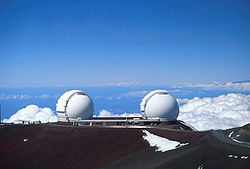- Mauna Kea Observatory
-
Mauna Kea Observatory 
The summit of Mauna Kea is managed by the University of Hawai'i's Institute for Astronomy. Mauna Kea is one of the most important land-based astronomy sites in the world.Organization University of Hawai'i Institute for Astronomy Code 568 Location Mauna Kea, Hawai'i, USA CoordinatesAltitude 4205m (13,800ft) Website
ifa.hawaii.edu/mkoTelescopesCSO 10.4 m submillimeter CFHT 3.58 m Cassegrain Gemini North 8.1 m Cassegrain IRTF 3.0 m infrared JCMT 15 m submillimeter Subaru 8.2 m optical SMA 8 6m arrayed radio telescopes UKIRT 3.8 m infrared VLBA receiver 25 m radio telescope W. M. Keck Observatory 2 10m optical/near infrared The Observatories at Mauna Kea, (MKO), are an independent collection of astronomical research facilities located on the summit of Mauna Kea on the Big Island of Hawai'i, USA. The facilities are located in a 500-acre (2.0 km2) special land use zone known as the "Astronomy Precinct," which is located in the Mauna Kea Science Reserve. The Astronomy Precinct was established in 1967 and is located on land protected by the Historical Preservation Act for its significance to Hawaiian culture.
The location is ideal because of its dark skies, good astronomical seeing, low humidity and position above most of the water vapor in the atmosphere, clean air, good weather and almost equatorial location.[1]
Contents
Ownership
The University of Hawai'i manages the site and leases land to several multi-national facilities which have invested more than $2 billion in science and technology.[citation needed]
Location
The altitude and isolation in the middle of the Pacific Ocean makes Mauna Kea one of the best locations on earth for ground-based astronomy. It is an ideal location for submillimeter, infrared and optical observations. The seeing statistics show that Mauna Kea is the best site in terms of optical and infrared image quality—for example the CFHT site has a median seeing of 0.43 arcseconds.
Accommodations for research astronomers are located at the Onizuka Center for International Astronomy (often called Hale Pōhaku), 7 miles by unpaved steep road from the summit at 9300 feet (2835 m) above sea level. An adjacent visitor information station is located at 9200 feet (2775 m). The summit of Mauna Kea is so high that tourists are advised to stop at the visitor station for at least 30 minutes to acclimate to atmospheric conditions before continuing to the summit, and scientists often stay at Hale Pōhaku for 8 hours or more before spending a full night at observatories on the summit, with some telescopes requiring observers to spend one full night at Hale Pōhaku before working at the summit.
Telescopes
Telescopes found at the summit of Mauna Kea are funded by government agencies of various nations. The University of Hawai'i itself directly administers two telescopes. In total there are 12 telescopes at or around the summit of Mauna Kea. It will also be the site of the Thirty Meter Telescope and is a proposed site for Pan-STARRS.
- Caltech Submillimeter Observatory (CSO): Caltech
- Canada France Hawai'i Telescope (CFHT): Canada, France, University of Hawai'i
- Gemini North Telescope: United States, United Kingdom, Canada, Chile, Australia, Argentina, Brazil
- Infrared Telescope Facility (IRTF): NASA
- James Clerk Maxwell Telescope (JCMT): United Kingdom, Canada, Netherlands
- Subaru Telescope: National Astronomical Observatory of Japan
- Sub-Millimeter Array (SMA): Taiwan, United States
- United Kingdom Infrared Telescope (UKIRT): United Kingdom
- University of Hawai'i 88-inch (2.2 m) telescope (UH88): University of Hawai'i
- University of Hawai'i 24-inch (610 mm) telescope (UH24): University of Hawaii at Hilo
- One receiver of the Very Long Baseline Array (VLBA): United States
- W. M. Keck Observatory: California Association for Research in Astronomy
2006 Hawaii earthquake
A number of the telescopes sustained minor damage during the October 15, 2006 Hawaii earthquake and aftershocks. Both CFHT and W. M. Keck Observatory were operational and back online by October 19.[2][3]
See also
- Timeline of telescopes, observatories, and observing technology
- Other major international observatories (under active development):
- Historically important observatories (not undergoing substantial development):
- Mount Wilson Observatory
- Kitt Peak Observatory
- Palomar Observatory
References
- ^ About Mauna Kea Observatories
- ^ "2006 October 15 Earthquake Aftermath at CFHT". Canada France Hawai'i Telescope. January 11, 2007. http://www.cfht.hawaii.edu/EARTHQUAKE/. Retrieved August 27, 2010.
- ^ "Earthquake Update from W. M. Keck Observatory". W. M. Keck Observatory. http://keckobservatory.org/news/earthquake_update_from_w._m._keck_observatory/. Retrieved August 27, 2010.
External links
- Mauna Kea Observatory web page
- Mauna Kea webcams
- Essay on visiting the Mauna Kea Observatories
- Weather forecast for Mauna Kea summit
- Photos of Mauna Kea from "A Gentle Rain of Starlight: The Story of Astronomy on Mauna Kea" by Michael J. West. ISBN 0-93154-899-3.
- Mauna Kea Visitor Information Station
- Office of Mauna Kea Management
- Thirty Meter Telescope Hawaii Environmental Impact Statement Process
- Mauna Kea Comprehensive Management Plan
Categories:- Buildings and structures in Hawaii County, Hawaii
- Astronomical observatories in Hawaii
- University of Hawaii
- Organizations based in Hawaii
- Research institutes in the United States
- Astronomy institutes and departments
Wikimedia Foundation. 2010.



